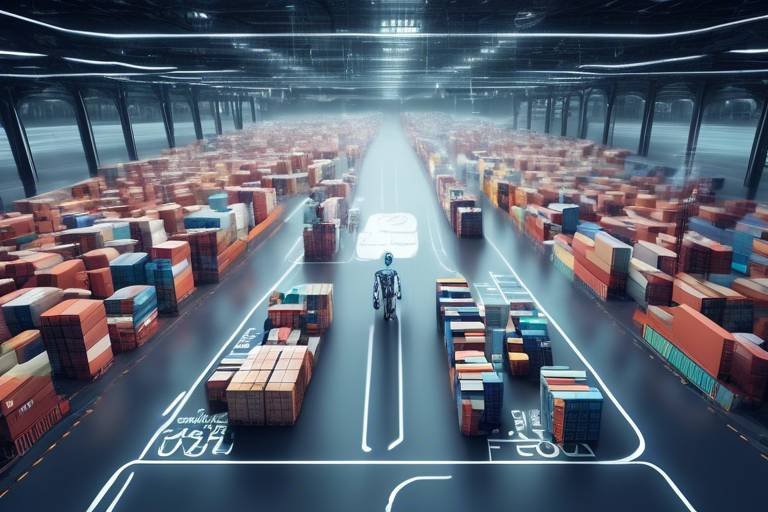AI Innovations in Water Management: Challenges and Opportunities
Water is the essence of life, yet we find ourselves grappling with a crisis that seems to be worsening by the day. The integration of artificial intelligence (AI) into water management offers a beacon of hope, illuminating pathways to tackle this pressing challenge. By leveraging advanced technologies, we can optimize water usage, enhance conservation efforts, and improve overall water quality. However, this journey is not without its hurdles. As we explore the transformative role of AI in water management, we must also confront the challenges that arise from this integration. So, what does the future hold? Are we ready to embrace these innovations, or will we allow obstacles to impede progress?
Water scarcity is a pressing global issue, exacerbated by climate change and population growth. The causes are multifaceted, ranging from over-extraction of water resources to pollution and inefficient usage. Communities worldwide are feeling the impact, with millions lacking access to clean water. Imagine living in a place where turning on the tap is a gamble—will water flow, or will you be met with an empty pipe? This stark reality underscores the urgency of finding effective solutions.
Artificial intelligence offers innovative solutions for water management, including predictive analytics and machine learning. These technologies can analyze vast amounts of data, identify patterns, and make recommendations that were previously unimaginable. For instance, AI can help predict water demand based on historical data, weather patterns, and even social events. This level of insight allows water managers to optimize distribution and minimize waste. It's like having a crystal ball that not only shows you the future but also guides you on how to navigate it.
Predictive analytics helps water managers allocate resources efficiently by forecasting demand and supply. Imagine a scenario where water managers can accurately predict a drought months in advance, allowing them to adjust plans proactively. AI-driven predictions can lead to better decision-making in water management, ensuring that every drop is utilized effectively. This is not just about saving water; it's about preserving our most precious resource for future generations.
Effective data collection is crucial for accurate predictive analytics. Various methods are employed to gather data for AI applications in water management, including IoT sensors and satellite imagery. IoT sensors can monitor water levels, quality, and usage in real-time, providing invaluable data that can be analyzed for trends and anomalies. Satellite imagery can track changes in land use and water bodies, offering a broader perspective on water resource management. Together, these technologies create a comprehensive picture of water availability and usage.
Real-world examples illustrate the successful application of predictive analytics in water management. One notable case is the use of AI in the city of Cape Town, South Africa, which faced severe water shortages in 2017. By implementing predictive analytics, the city was able to forecast water demand and adjust its supply strategies accordingly, ultimately averting a crisis. Another example can be found in California, where AI-driven models have helped farmers optimize irrigation schedules based on real-time weather data, leading to significant water savings. These case studies highlight the potential of AI to improve efficiency and sustainability in water resource allocation.
Despite the benefits, implementing AI in water management faces several challenges. Technical hurdles, such as data integration and system compatibility, can slow down progress. Financial constraints also pose a significant barrier, as many water management agencies struggle to find the budget for advanced technologies. Additionally, regulatory frameworks often lag behind technological advancements, creating uncertainty for stakeholders. Overcoming these challenges requires collaboration among governments, tech companies, and communities.
AI presents numerous opportunities for promoting sustainable water management practices. By enhancing conservation efforts and improving water quality, these technologies can lead to a more sustainable future. For instance, AI can analyze water quality data in real-time, allowing for immediate responses to contamination events. This proactive approach not only protects public health but also fosters trust in water management systems.
AI can significantly improve water quality monitoring through real-time analysis and anomaly detection. Imagine a system that can instantly alert authorities to a sudden spike in pollutants, enabling swift action to safeguard the water supply. Advanced monitoring systems equipped with AI capabilities can ensure safe and clean water for communities, making water quality management more efficient and effective.
Involving communities in water management is essential for sustainability. AI can foster community engagement and educate the public about water conservation practices. By providing accessible information and tools, communities can take an active role in managing their water resources. This collaborative approach not only empowers individuals but also builds a sense of ownership and responsibility towards water conservation.
- What is the role of AI in water management? AI helps optimize water usage, improve predictive analytics, and enhance water quality monitoring.
- What are some examples of AI applications in water management? Examples include predictive analytics for resource allocation and real-time water quality monitoring systems.
- What challenges does AI face in water management? Challenges include technical hurdles, financial constraints, and regulatory issues.
- How can communities get involved in water management? Communities can engage through education, participation in conservation efforts, and utilizing AI tools for better resource management.

Understanding Water Scarcity
Water scarcity is not just a buzzword; it's a **serious global crisis** that affects millions of people every day. Imagine waking up and turning on your tap, only to find that no water flows out. This scenario is becoming increasingly common in various parts of the world, where the demand for water far exceeds the available supply. The roots of water scarcity are deep and complex, intertwined with factors like **climate change**, **population growth**, and **poor water management** practices.
The implications of water scarcity are profound. Communities face a myriad of challenges, including reduced agricultural productivity, increased competition for water resources, and heightened tensions among users. In places where water is scarce, you might find families spending hours each day just to collect a few gallons. This struggle not only affects their daily lives but also impacts their health, education, and economic opportunities.
So, what exactly causes water scarcity? Here are some of the primary culprits:
- Climate Change: Altered weather patterns lead to droughts and unpredictable rainfall, making it difficult to rely on traditional water sources.
- Population Growth: As the global population continues to rise, the demand for water increases exponentially, putting pressure on existing resources.
- Pollution: Contaminated water sources reduce the amount of clean water available, further straining supplies.
- Over-extraction: Excessive withdrawal of water from rivers, lakes, and aquifers leads to depletion of these vital resources.
Communities around the world are feeling the heat of water scarcity, and it's not just a distant problem. From the parched deserts of the Middle East to the drought-stricken regions of sub-Saharan Africa, the effects are tangible. In fact, according to the United Nations, by 2025, 1.8 billion people will live in areas plagued by absolute water scarcity. This statistic should send chills down our spines and motivate us to act.
Moreover, the economic ramifications of water scarcity are staggering. Industries that depend heavily on water, such as agriculture and manufacturing, face significant challenges, leading to job losses and economic downturns. The World Bank estimates that water scarcity could cost some regions up to **6% of their GDP**. It’s a wake-up call for policymakers and communities alike to prioritize sustainable water management practices.
As we navigate through this crisis, it’s crucial to understand that water scarcity is not merely a supply issue; it's also about **equitable distribution** and **efficient management**. The solutions will require innovative approaches and a collective effort from governments, organizations, and individuals. Only by working together can we hope to tackle the challenges posed by water scarcity and ensure a sustainable future for all.

AI Technologies in Water Management
Artificial Intelligence (AI) is revolutionizing the way we manage our most precious resource: water. With the increasing pressures of climate change, urbanization, and population growth, traditional methods of water management are often insufficient. Enter AI, a powerful ally that provides innovative solutions designed to optimize water usage and distribution. Imagine being able to predict water demand before it even arises, or detecting leaks in a pipe system before they become a costly disaster. Sounds like science fiction? Well, it's becoming a reality!
AI technologies are diverse and can be applied in various aspects of water management. For instance, machine learning algorithms analyze historical data to identify patterns and make predictions about future water needs. These algorithms can process vast amounts of data from multiple sources, such as weather forecasts, population statistics, and historical usage trends, to create a comprehensive picture of water demand. This predictive capability allows water managers to allocate resources more effectively, ensuring that supply meets demand without unnecessary waste.
Another exciting application of AI in water management is through IoT (Internet of Things) devices. These smart devices collect real-time data on water quality, flow rates, and pressure levels. By integrating IoT with AI, water management systems can continuously monitor conditions and automatically adjust operations to maintain optimal performance. For example, if a sudden spike in water usage is detected, the system can alert managers to potential leaks or other issues, enabling them to respond swiftly and minimize water loss.
Moreover, AI-driven models can significantly enhance water quality monitoring. By employing advanced sensors and machine learning techniques, these systems can analyze water samples in real-time, detecting contaminants and anomalies that could pose risks to public health. This proactive approach not only ensures safe drinking water but also helps in maintaining the ecological balance in natural water bodies.
To illustrate the potential of AI in water management, consider the following table that highlights some of the key technologies and their applications:
| AI Technology | Application |
|---|---|
| Machine Learning | Forecasting water demand and optimizing resource allocation. |
| IoT Devices | Real-time monitoring of water quality and system performance. |
| Predictive Analytics | Identifying trends and potential issues in water supply systems. |
| Data Analytics | Analyzing historical data to inform future water management strategies. |
In conclusion, the integration of AI technologies into water management practices is not just a trend; it’s a necessity for sustainable living. The potential for enhanced efficiency, improved water quality, and proactive management of resources is immense. As communities and organizations continue to embrace these technologies, we can look forward to a future where water scarcity is managed more effectively, ensuring that this vital resource is preserved for generations to come.
- What is AI in water management? AI in water management refers to the use of artificial intelligence technologies to optimize the usage, distribution, and quality of water resources.
- How does predictive analytics improve water management? Predictive analytics uses historical data to forecast future water demand and supply, allowing for better resource allocation and decision-making.
- What role do IoT devices play in water management? IoT devices collect real-time data on water conditions, helping to monitor and manage systems more effectively.
- Can AI help in improving water quality? Yes, AI can enhance water quality monitoring through real-time analysis and anomaly detection, ensuring safe drinking water.

Predictive Analytics for Resource Allocation
In the dynamic world of water management, predictive analytics serves as a lighthouse guiding resource allocation amidst the turbulent waters of demand and supply. Imagine trying to navigate a ship without a map or compass; that’s what water managers face without the insights provided by AI-driven predictions. Predictive analytics utilizes historical data and advanced algorithms to forecast future water usage, allowing managers to make informed decisions that can significantly enhance efficiency.
One of the standout features of predictive analytics is its ability to analyze vast amounts of data from various sources, such as weather patterns, historical consumption rates, and population growth trends. By integrating these data points, water managers can anticipate fluctuations in water demand and supply. For example, during drought seasons, predictive models can alert managers to potential shortages, enabling them to implement conservation measures before a crisis occurs. This proactive approach not only ensures the sustainability of water resources but also fosters a culture of responsible water usage among communities.
Moreover, the application of predictive analytics in resource allocation extends beyond just managing shortages. It also plays a crucial role in optimizing distribution systems. By predicting peak usage times and identifying areas with potential leaks or inefficiencies, water managers can allocate resources more effectively. This means less water is wasted, and communities receive a more reliable supply. In essence, predictive analytics transforms water management from a reactive process into a strategic endeavor, paving the way for smarter, data-driven decisions.
To illustrate this further, consider a city that has implemented predictive analytics in its water management system. The city collects data from various sources, including IoT devices that monitor water flow and quality in real-time. Using this data, the predictive model can forecast when water demand will spike, such as during the summer months when residents are more likely to water their lawns. With these insights, the city can adjust its water distribution strategies accordingly, ensuring that supply meets demand without over-extraction from local sources.
In conclusion, the integration of predictive analytics into water resource allocation not only enhances operational efficiency but also plays a vital role in promoting sustainability. By harnessing the power of AI, water managers can navigate the complexities of resource management with greater precision and foresight, ultimately leading to a more secure and sustainable water future for all.
- What is predictive analytics? Predictive analytics is a statistical technique that uses historical data, machine learning, and algorithms to predict future outcomes.
- How does predictive analytics benefit water management? It helps in forecasting water demand and supply, allowing for better resource allocation and conservation strategies.
- What types of data are used in predictive analytics? Data from various sources, including weather patterns, historical consumption rates, and IoT sensors, are utilized.
- Can predictive analytics help during droughts? Yes, it can forecast potential shortages and help implement conservation measures proactively.
- Is AI in water management cost-effective? While there are initial costs, the long-term savings from reduced waste and improved efficiency often outweigh these expenses.

Data Collection Methods
In the realm of water management, effective data collection serves as the backbone for harnessing the power of AI. Without accurate and timely data, predictive analytics can fall flat, leading to misguided decisions that could exacerbate water scarcity rather than alleviate it. So, what are the most effective methods for gathering this vital information? Let's dive in!
One of the most revolutionary tools in the data collection arsenal is the Internet of Things (IoT). IoT devices, such as smart sensors and meters, can be deployed throughout water systems to monitor various parameters, including flow rates, water quality, and pressure levels. These sensors provide real-time data, enabling water managers to respond swiftly to issues as they arise. Imagine having a network of tiny sentinels, constantly watching over your water resources, ready to alert you at the first sign of trouble!
Another innovative approach involves the use of satellite imagery. Satellites equipped with advanced imaging technology can capture vast amounts of data about surface water bodies, land use, and vegetation cover. This information is invaluable for understanding regional water availability and for planning conservation efforts. For instance, satellite data can help identify areas experiencing drought or excessive water usage, allowing for targeted interventions. It's like having a bird's-eye view of the entire water landscape!
Moreover, traditional methods such as surveys and field measurements still hold their ground. While they may not be as high-tech, these methods provide essential baseline data that can complement IoT and satellite information. Water managers often conduct surveys to understand community water usage patterns and to gauge public sentiment regarding water conservation practices. This qualitative data can be just as important as quantitative data, helping to shape more effective policies.
To sum it up, the integration of various data collection methods is crucial for optimizing water management. The combination of IoT sensors, satellite imagery, and traditional surveys creates a comprehensive data framework that supports informed decision-making. By leveraging these technologies, water managers can ensure that they are not just reacting to problems but proactively managing resources in a sustainable way.
- What is the role of AI in water management?
AI helps optimize water usage, predict supply and demand, and improve efficiency in water distribution. - How does IoT contribute to data collection?
IoT devices provide real-time monitoring of water systems, allowing for immediate responses to issues. - Can satellite imagery improve water management?
Yes, it offers a comprehensive view of water resources and can identify areas needing attention. - What challenges exist in implementing these technologies?
Challenges include technical difficulties, financial constraints, and regulatory hurdles.

Case Studies in Predictive Analytics
Predictive analytics has emerged as a game-changer in water management, providing actionable insights that have reshaped how we approach resource allocation. One notable case study comes from the city of Los Angeles, where the Department of Water and Power implemented an AI-driven system to optimize water distribution. By analyzing historical data and current usage patterns, the system was able to forecast demand spikes during the summer months, allowing the city to allocate resources more effectively. This proactive approach not only reduced waste but also ensured that residents had access to water during peak usage times.
Another compelling example is seen in Singapore, where the government has integrated predictive analytics with their smart water management system. By utilizing IoT sensors and real-time data, Singapore's water authorities can monitor water quality and supply levels continuously. The predictive model alerts managers to potential issues before they escalate, enabling quick interventions. For instance, during a recent drought, the system predicted a significant drop in reservoir levels weeks in advance, prompting authorities to implement conservation measures that saved millions of gallons of water.
The Netherlands also showcases the power of predictive analytics in managing flood risks. With a complex network of waterways, the Dutch government employs AI to predict rainfall patterns and water levels across the country. This predictive capability allows for timely alerts to residents in flood-prone areas, significantly reducing the risk of property damage and loss of life. The integration of machine learning algorithms has improved the accuracy of these predictions, making it possible to simulate various scenarios and plan accordingly.
These case studies highlight the transformative potential of predictive analytics in water management. By leveraging data and AI technologies, cities can enhance their operational efficiency and sustainability efforts. However, the success of these initiatives relies heavily on accurate data collection and analysis. As we look toward the future, the integration of predictive analytics in water management will likely become a standard practice globally.
- What is predictive analytics?
Predictive analytics involves using statistical algorithms and machine learning techniques to identify the likelihood of future outcomes based on historical data.
- How does AI help in water management?
AI assists in water management by optimizing resource allocation, predicting demand, and improving water quality monitoring through advanced data analysis.
- Can predictive analytics prevent water scarcity?
While it cannot eliminate water scarcity, predictive analytics can help manage resources more efficiently, potentially mitigating its effects.
- What are the challenges of implementing AI in water management?
Challenges include technical issues, high implementation costs, and regulatory hurdles that need to be addressed for successful integration.

Challenges in Implementing AI Solutions
Implementing AI solutions in water management is not as straightforward as it may seem. While the potential benefits are enormous, several challenges can impede progress. First and foremost, the technical complexity of integrating AI systems into existing water management frameworks can be daunting. Many water utilities still rely on outdated infrastructure, making it difficult to adopt new technologies without significant investment. This creates a financial burden that many organizations are not prepared to handle.
Moreover, the data quality issue looms large. AI systems thrive on data, and if the data collected is incomplete or inaccurate, it can lead to poor decision-making. For instance, if sensors malfunction or data is not updated in real-time, the predictions made by AI could be off the mark, leading to inefficient resource allocation. This is particularly concerning in regions already facing water scarcity, where every drop counts.
Another significant challenge is the regulatory landscape. The water management sector is often governed by strict regulations aimed at ensuring safety and compliance. Integrating AI solutions requires navigating these regulations, which can vary widely by region. Companies may find themselves in a quagmire of compliance issues that slow down or even halt the implementation of AI technologies.
Furthermore, there’s the human factor to consider. Many stakeholders in water management, from policymakers to field workers, may lack the necessary understanding of AI technologies. This knowledge gap can lead to resistance against adopting AI solutions, as people may fear that these technologies will replace their jobs or disrupt established practices. Thus, it’s crucial to foster a culture of collaboration and education within organizations to overcome this barrier.
In addition to these challenges, the issue of cybersecurity cannot be overlooked. As water management systems become increasingly connected through IoT devices and AI, they also become more vulnerable to cyberattacks. A breach could not only compromise sensitive data but also disrupt water supply systems, posing serious risks to public health and safety. This concern necessitates robust cybersecurity measures to protect these advanced systems.
In summary, while AI holds great promise for revolutionizing water management, the path to implementation is fraught with challenges. Addressing these hurdles requires a concerted effort from all stakeholders involved, including investment in technology, training for personnel, and the establishment of clear regulatory frameworks. Only then can we harness the full potential of AI to create a more sustainable and efficient water management system.
- What are the main challenges in implementing AI in water management?
The main challenges include technical complexity, data quality issues, regulatory hurdles, the human factor, and cybersecurity concerns. - How can organizations overcome resistance to AI adoption?
Organizations can overcome resistance by fostering a culture of collaboration and education, ensuring that all stakeholders understand the benefits and workings of AI technologies. - What role does data quality play in AI effectiveness?
Data quality is crucial for AI effectiveness, as inaccurate or incomplete data can lead to poor decision-making and inefficient resource allocation. - Why is cybersecurity a concern for AI in water management?
As water systems become more connected, they are more vulnerable to cyberattacks, which can compromise sensitive data and disrupt services.

Opportunities for Sustainable Practices
As we navigate the complexities of water management, the integration of artificial intelligence (AI) opens up a world of possibilities for sustainable practices. The challenges posed by water scarcity and pollution are daunting, but AI provides innovative solutions that can transform how we manage this precious resource. Imagine a world where water is not just managed, but optimized through intelligent systems that anticipate needs and enhance conservation efforts. This is not just a dream; it’s becoming a reality thanks to AI.
One of the most significant opportunities AI offers is in the realm of water conservation. By utilizing advanced algorithms, AI can analyze vast amounts of data to identify patterns in water usage and detect areas where waste occurs. For instance, smart irrigation systems powered by AI can adjust water delivery based on weather forecasts and soil moisture levels, ensuring crops receive just the right amount of water they need. This precision not only conserves water but also boosts agricultural productivity, creating a win-win situation for farmers and the environment.
Moreover, AI enhances water quality monitoring. Traditional methods of testing water quality can be time-consuming and often lag behind real-time needs. However, with the integration of AI, we can leverage real-time data analytics to monitor water quality continuously. AI systems can detect anomalies, such as sudden increases in contaminants, alerting authorities to potential issues before they escalate. This capability is crucial for ensuring that communities have access to safe and clean water, which is fundamental for public health.
Community engagement is another area where AI can make a significant impact. By utilizing AI-driven platforms, local governments and organizations can educate communities about water conservation practices. For example, AI can analyze community water usage patterns and provide tailored recommendations to households on how to reduce their consumption. As people become more informed about their water usage, they are more likely to adopt sustainable practices. This creates a ripple effect, where individual actions contribute to broader conservation efforts.
To illustrate the potential of AI in promoting sustainable practices, consider the following table that summarizes key opportunities:
| Opportunity | Description | Benefits |
|---|---|---|
| Water Conservation | AI optimizes irrigation and water usage through data analysis. | Reduces waste, increases agricultural productivity. |
| Water Quality Monitoring | Real-time analysis of water quality for early detection of contaminants. | Ensures safe drinking water, protects public health. |
| Community Engagement | AI platforms educate communities on sustainable practices. | Promotes awareness, encourages responsible usage. |
In conclusion, the integration of AI in water management is not just about technology; it’s about creating a sustainable future for our communities and the planet. By harnessing the power of AI, we can tackle the pressing challenges of water scarcity and quality, ensuring that future generations inherit a world where water is abundant and safe. The journey may be challenging, but the opportunities are vast, and the potential for positive change is immense.
1. How does AI improve water conservation?
AI improves water conservation by analyzing usage patterns and optimizing irrigation systems, ensuring that water is used efficiently and effectively.
2. What role does AI play in water quality monitoring?
AI plays a crucial role in water quality monitoring by providing real-time data analysis, detecting contaminants quickly, and alerting authorities to potential health risks.
3. How can communities benefit from AI in water management?
Communities can benefit from AI through enhanced education on water conservation practices, personalized recommendations for reducing water usage, and improved access to safe drinking water.

Enhancing Water Quality Monitoring
In an era where clean water is becoming increasingly scarce, the importance of effective water quality monitoring cannot be overstated. Artificial Intelligence (AI) has emerged as a game-changer in this domain, enabling real-time analysis and anomaly detection that traditional methods simply cannot match. Imagine a world where water quality is monitored continuously, with instant alerts for any irregularities—this is not just a dream but a reality that AI is helping to create.
One of the most compelling advantages of AI in water quality monitoring is its ability to process vast amounts of data quickly and accurately. By leveraging machine learning algorithms, AI systems can analyze data from various sources, such as IoT sensors, satellite imagery, and historical records, to identify patterns and predict potential issues before they escalate. For instance, if a sensor detects a sudden spike in contaminants, AI can immediately assess the situation, determine its potential causes, and recommend actions to mitigate the problem.
Moreover, AI enhances the monitoring process through anomaly detection. Traditional monitoring methods often rely on periodic testing, which can miss transient events that could have severe implications for public health. In contrast, AI systems can continuously analyze data streams, identifying outliers that may indicate contamination or other issues. This capability not only ensures quicker responses but also provides a more comprehensive understanding of water quality over time.
To illustrate the impact of AI on water quality monitoring, let's take a look at a few key applications:
- Real-time Monitoring: AI systems can provide continuous updates on water quality metrics such as pH levels, turbidity, and chemical concentrations, allowing for immediate intervention when necessary.
- Predictive Maintenance: By analyzing historical data, AI can predict when equipment is likely to fail, enabling proactive maintenance and reducing downtime.
- Automated Reporting: AI can generate reports automatically, summarizing water quality data and trends, which helps stakeholders make informed decisions.
In addition, AI can facilitate collaboration among various stakeholders involved in water management. By providing a centralized platform for data sharing, AI fosters communication between government agencies, environmental organizations, and local communities. This collaboration is crucial for developing effective strategies to tackle water quality issues and ensuring that everyone is on the same page.
As we move forward, the integration of AI in water quality monitoring will likely become even more sophisticated. With advancements in sensor technology and data analytics, we can expect more accurate and reliable monitoring systems that can handle the complexities of modern water resources. However, it is essential to address the challenges associated with AI implementation, such as data privacy concerns and the need for regulatory frameworks, to fully harness its potential.
In conclusion, enhancing water quality monitoring through AI not only improves our ability to detect and respond to water quality issues but also paves the way for more sustainable water management practices. As we embrace these innovative technologies, we are taking significant steps toward ensuring safe and clean water for future generations.
Q: How does AI improve water quality monitoring?
A: AI enhances water quality monitoring by enabling real-time data analysis, anomaly detection, and predictive maintenance, allowing for quicker responses to potential issues.
Q: What types of data does AI use for monitoring?
A: AI utilizes data from IoT sensors, satellite imagery, and historical records to assess water quality and identify trends.
Q: Can AI help in community engagement regarding water quality?
A: Yes, AI can facilitate data sharing among stakeholders, promoting collaboration and awareness about water quality issues within communities.

Community Engagement and Education
Community engagement and education are vital components in the quest for sustainable water management. When communities are actively involved in managing their water resources, they not only become more aware of the challenges but also take ownership of the solutions. Imagine a community where every individual understands the importance of conserving water and how their actions contribute to the overall health of their environment. This is not just a dream; it can be a reality through effective use of artificial intelligence (AI) and innovative educational strategies.
One of the most exciting aspects of AI in water management is its ability to facilitate real-time communication and feedback between water authorities and the community. For instance, AI-driven platforms can provide residents with personalized water usage reports, alert them to leaks, and offer tips on how to reduce consumption. This kind of engagement transforms the often passive relationship between water providers and users into an interactive partnership. When people see their water usage data and understand the impact of their habits, they are more likely to change for the better.
Moreover, educational initiatives powered by AI can significantly enhance public knowledge about water conservation. Through tailored workshops, interactive online courses, and community events, residents can learn about:
- The importance of water conservation
- How climate change affects local water supplies
- Best practices for reducing water waste at home
- Ways to participate in local water management initiatives
By leveraging technology, organizations can create engaging educational content that resonates with various demographics. For example, gamification techniques can be applied to make learning about water conservation fun and engaging for younger audiences. Imagine a mobile app that rewards users for tracking their water usage or completing conservation challenges. This not only educates but also motivates individuals to take action.
In addition to technology-driven initiatives, fostering a culture of collaboration within the community is essential. Local governments, non-profits, and educational institutions can work together to create programs that encourage community participation. Events such as water clean-up days, workshops on sustainable gardening, and school projects focused on water conservation can cultivate a sense of community pride and responsibility. When people come together to tackle issues, they often find innovative solutions that might not be apparent in isolation.
Ultimately, the goal of community engagement and education in water management is to create informed citizens who are equipped to make sustainable choices. By utilizing AI technologies to enhance communication, provide valuable insights, and foster community involvement, we can pave the way for a more sustainable and resilient approach to managing our precious water resources.
Q: How can AI improve community engagement in water management?
A: AI can provide real-time data and personalized insights to residents, enabling them to understand their water usage better and encouraging them to participate in conservation efforts.
Q: What role does education play in sustainable water management?
A: Education empowers individuals with knowledge about water conservation practices, the impact of climate change, and ways to engage in community initiatives, fostering a culture of sustainability.
Q: Are there any successful examples of community engagement in water management?
A: Yes, many communities have implemented programs that involve residents in decision-making processes, such as water clean-up events and conservation challenges, leading to improved water management outcomes.
Frequently Asked Questions
- What is water scarcity and why is it a global issue?
Water scarcity refers to the lack of sufficient water resources to meet the demands of water usage within a region. It's a pressing global issue primarily driven by factors like climate change, population growth, and inefficient water management practices. As more people inhabit the planet, the strain on our water resources intensifies, leading to dire consequences for communities, agriculture, and ecosystems.
- How can AI help in managing water resources?
AI can revolutionize water management by providing innovative solutions such as predictive analytics, machine learning, and real-time monitoring. These technologies can optimize water usage, forecast demand, and improve resource allocation, ensuring that water is used efficiently and sustainably. By analyzing vast amounts of data, AI can identify patterns and make informed decisions that traditional methods might overlook.
- What are predictive analytics and how do they work in water management?
Predictive analytics involves using historical data and AI algorithms to forecast future water demand and supply. By analyzing trends, weather patterns, and consumption rates, water managers can allocate resources more effectively. This proactive approach helps in making better decisions, preventing shortages, and ensuring that water is available where it is needed most.
- What methods are used for data collection in AI water management?
Effective data collection is crucial for the success of AI applications in water management. Common methods include IoT sensors that monitor water quality and usage in real-time, satellite imagery for tracking water bodies, and traditional data collection techniques. These tools provide the necessary information to feed AI systems, enabling accurate predictive analytics.
- What challenges do we face in implementing AI solutions for water management?
Implementing AI in water management comes with several challenges, including technical difficulties, high costs, and regulatory hurdles. Organizations may struggle with integrating new technologies into existing systems, securing funding for innovative projects, and navigating the complex regulatory landscape surrounding water resources. Overcoming these challenges is essential for successful integration.
- How does AI enhance water quality monitoring?
AI enhances water quality monitoring by enabling real-time analysis and anomaly detection. Advanced algorithms can process data from various sources to identify contaminants and other issues quickly. This capability ensures that water remains safe for consumption and helps in taking prompt action to address any quality concerns.
- Why is community engagement important in water management?
Community engagement is vital for sustainable water management because it fosters awareness and encourages responsible water usage. By involving local communities in decision-making processes and educating them about conservation practices, we can promote a culture of sustainability that leads to long-term positive impacts on water resources.



















